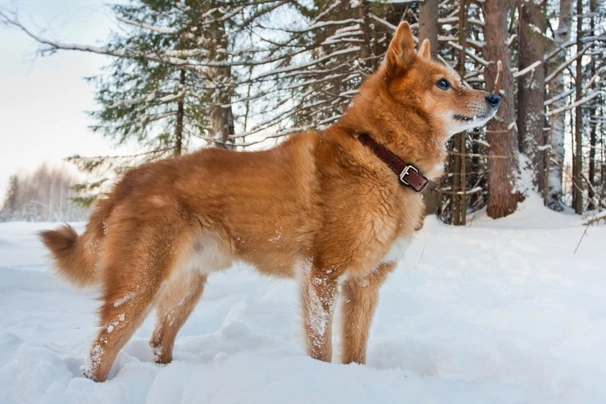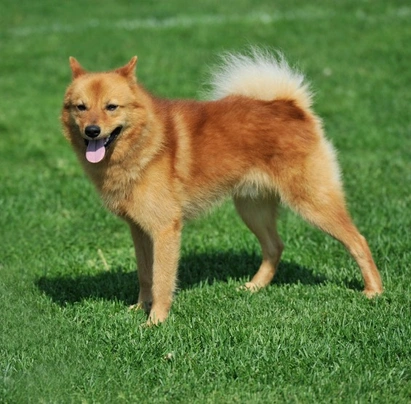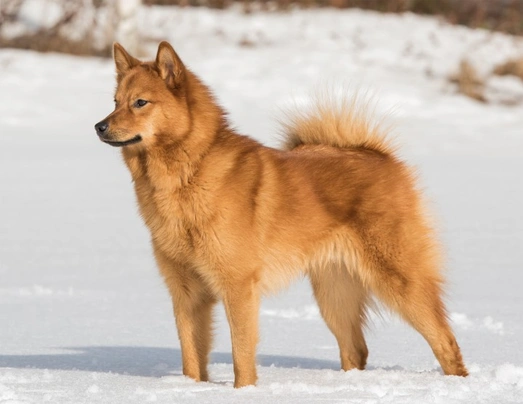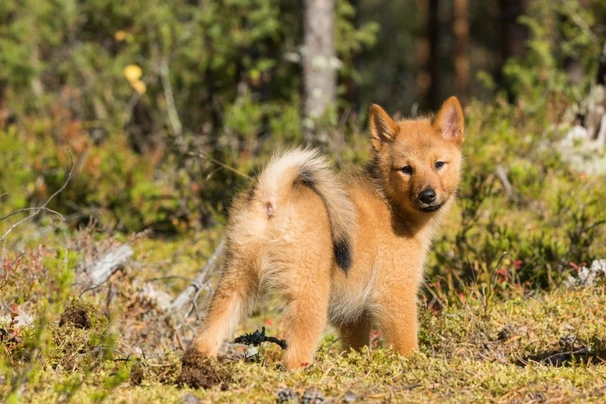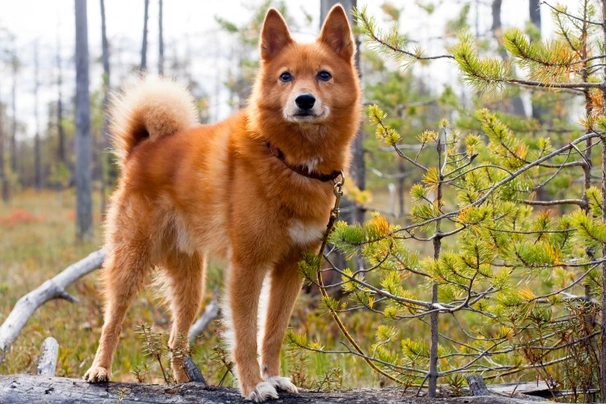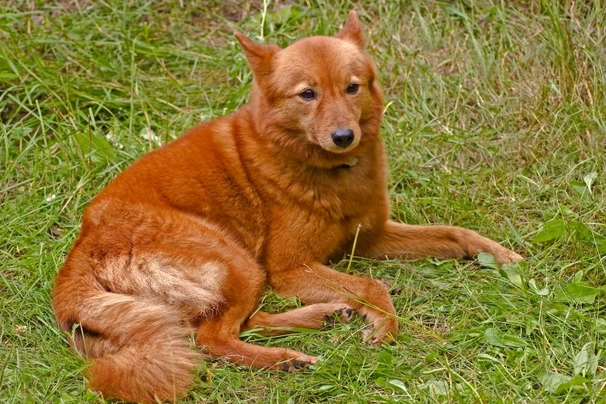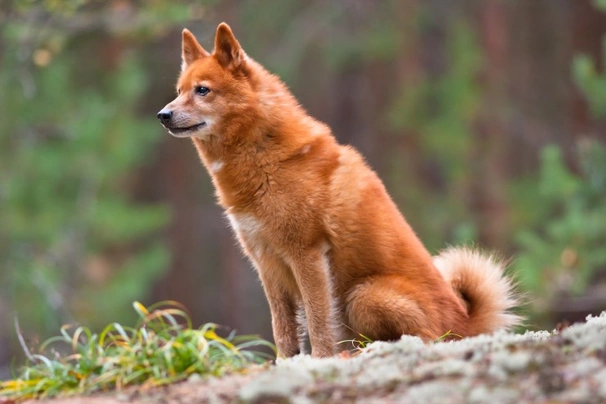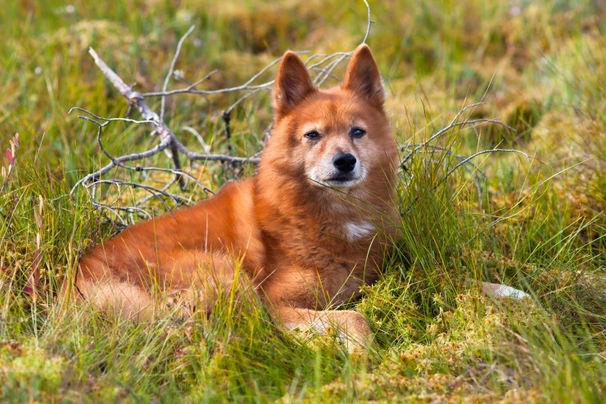Finnish Spitz
Pros
Cons
Introduction of the Finnish Spitz
The Finnish Spitz is an attractive dog with their red coats and fox like looks. They are Finland's national dog and although not so well known outside of their native land they are highly prized in Scandinavian countries thanks to their charming looks and kind courageous natures. They seem to have a natural affinity with children which makes the Finnish Spitz a great choice as a family pet and being so adaptable they are just at home in a family environment as they are in a working one.
History of the Finnish Spitz
The ancestry of the Finnish Spitz is fascinating with Spitz-type dogs that roamed Russia for thousands of years having been used to create the breed. These ancient Russian breeds were used by tribes in the far north of Finland who developed dogs capable of working in many regions doing specific jobs which often included hunting for food. As the breeds were developed the Finnish Spitz as we now know it became the favourite choice due to their superior hunting ability and courageous loyal natures.
During the late 19th century as people moved to different areas of the country they took their dogs with them. These Spitz-type dogs were crossed with local dogs that boasted diverse ancestries and as a result the breed was almost lost altogether and at one point in time their numbers dwindled to dangerously low levels. Fortunately a Finnish sportsman by the name of Hugo Roos became a fan of the dogs recognising their potential as both working dogs and companions. He set up a breeding programme which saved the Finnish Spitz from extinction and prevented further dilution of the breed because so many were outcrossed to other breeds.
The Finnish Spitz is Finland's national dog and although not so well known outside of Scandinavia they are still highly prized in their native land. All the dogs we see today are descendants of the foundation stock developed by Hugo Roos. Sadly very few puppies are registered with The Kennel Club every year although the breed has always remained extremely popular in Holland America Canada New Zealand and Australia but less so here in the UK. As such well-bred puppies can often command a lot of money and waiting lists tend to be quite long.
Interesting facts about the breed
- Is the Finnish Spitz a vulnerable breed? No they have fast become a popular breed in the UK and have always been highly prized in their native Finland
- The Finnish Spitz is Finland’s national dog
- They are really a “gun dog” even though they are classed in the Hound Group by the Kennel Club
- Because of their thick coats they can easily overheat in hotter weather
- They are affectionately known as “piki nokka” in Finland which means “pitch black nose”
- They are called Suomen-pystyykorva in Finland which translated means “Finnish prick-eared dog” their name was shortened to Finsk Spets which then became “Finnish Spitz” in English
- The Finnish Spitz is still used on remote farms in Scandinavia where they hunt large game birds which are known as capercaillie elk and even bears
- They are trained to follow a bird ahead of the hunter until it settles at which point a Finnish Spitz runs backwards and forwards swaying their tails to get the bird’s attention. This lulls the bird into feeling safe as a dog begins to bark softly before barking louder top get their handler’s attention no matter how far they are away. The dogs bark is so loud it drowns out the sound of the approaching hunter.
- In Scandinavia there are barking competitions held for Finnish Spitz called the “King of the Barkers”
- Puppies are born with dark grey grey or fawn coats with lots of black and white markings but their coats change colour as they mature and can even change later in a dog’s life too
Appearance of the Finnish Spitz
Height at the withers: Males 38 - 51 cm Females 38 - 51 cm
Average weight: Males 14 - 16 kg Females 14 - 16 kg
The Finnish Spitz does resemble a fox with their lovely red coats and narrow muzzles. They are handsome dogs that boast having a clean-cut head that's longer than it is broad. Their muzzles are narrow and taper nicely to the end of a black nose that contrasts nicely with a dog's coat colour and adding their fox like looks. Their lips are also black and tight.
Their eyes are almond shaped being medium in size and dark in colour with dogs always boasting a bit of glint in them. Ears are small soft to the touch and pointed with dogs typically carrying them cocked. The Finnish Spitz has a strong jaw with a perfect scissor bite where their upper teeth neatly overlap their lower ones. Their necks are moderately long and muscular with a male's neck appearing a little shorter thanks to the much thicker ruff around their necks.
Their forequarters are strong with dogs boasting quite a square outline and straight front legs. They have deep chests nice level backs with their bellies being slightly tucked up. Their hindquarters are strong looking with dogs having well-muscled back legs. Feet are neat and round with dogs boasting nicely plumed tails are nicely which they carry curled from the base.
When it comes to their coat the Finnish Spitz has short tight hair on their heads and on the front of their legs whereas the hair on their body as well as the back of their legs is longer and it stands semi-erect. The hair on a dog's neck and back is a lot stiffer than on the rest of their body. They have a double coat with the outer one being quite a bit coarser and longer on a dog's shoulders. Their undercoat is much shorter softer and denser providing a lot of protection from the elements. Accepted breed colours for Kennel Club registration are as follows:
- Red
- Red Gold
It is worth noting that the accepted breed colours for Kennel Club registration can differ from those set out in the breed standard which are as follows:
- A dog’s back should be reddish-brown or red gold and ideally very bright. The hairs on a dog’s inner sides of their ears cheeks under the muzzle on their breast abdomen behind the shoulders on the inside of their legs back of their thighs underside of their tails being a lighter shade. A dog’s undercoat should be a lighter colour which gives the impression of a dog having a “glow” to their coats. A narrow white stripe is allowed on a dog’s breast and black hairs on their lips with a few separate black pointed hairs being permitted on their backs and tails. Finnish Spitz puppies can have black hairs which disappear as they mature although remain on their tails that much longer
Gait/movement
When a Finnish Spitz moves they do so with a springy light action showing a lot of drive while remaining graceful and quick too.
Faults
The Kennel Club frowns on any exaggerations or departures from the breed standard and would judge the faults on how much they affect a dog's overall health and wellbeing as well as their ability to perform.
Males should have both testicles fully descended into their scrotums and it is worth noting that a dog can be a little lighter or heavier as well as slightly taller or shorter than set out in the Kennel Club breed standard which is only given as a guideline.
Temperament of the Finnish Spitz
The Finnish Spitz is an alert and lively dog. There is nothing more they like than to be kept busy because they are incredibly active characters by nature. As such they need one or two good walks a day. If they get enough exercise and mental stimulation on a daily basis they are a real joy to have around and will relax when they are indoors. In short they thrive on plenty of outdoor exercise and love to be involved in everything that goes on in a household.
They are always ready to play - particularly with children yet they are not persistent. If they get ignored they will generally just walk away. They tend to be protective and fiercely loyal of their masters but they are known to be rather aloof with strangers although rarely would a Finnish Spitz show any sort of aggressive behaviour towards people they don't know preferring to just keep their distance and stay out of the way.
Potential owners should note that the Finnish Spitz has a tendency to bark which is a trait that’s been bred into them over a long period of time and which they needed for when they were hunting. To avoid excessive barking dogs need to be taught from a young age not to bark for the sake of it. With this said in Scandinavia they are prized for their barking abilities with competitions being held to find the best barkers in the land.
They are not the best choice for first time owners because they need to be trained by people who are familiar with the breed or similar type of dog and who would therefore understand all their needs.
Are they a good choice for first time owners?
A Finnish Spitz is not the best choice for first time owners because they need to be socialised handled and correctly trained by people who are familiar with the needs of such a lively extremely intelligent dog. They could quickly get the better of a novice owner and start to show a more dominant side to their natures making them harder to manage and live with.
What about prey drive?
A Finnish Spitz has a high prey drive and will happily chase anything that moves or tries to run away from them. As such care must always be taken as to where and when a dog can run off the lead more especially if there is livestock or wildlife close by.
What about playfulness?
Finnish Spitz have a very playful side to their natures and love to entertain and be entertained. They are known to be a little mischievous when the mood takes them and being so clever they quickly learn what pleases an owner and how to get their own way.
What about adaptability?
Although the Finnish Spitz is a very adaptable character by nature they enjoy being out and about which means they are better suited to people who have well-fenced back gardens that a dog can safely roam in whenever possible to really let off steam. They are extremely lively by nature and don’t do well when they don’t have something to do.
What about separation anxiety?
Although the Finnish Spitz forms strong ties with their families they are independent by nature and don’t typically mind being left to their own devices providing it is never for too long which can lead to them being destructive around the home which is a dog's way of relieving any stress they are feeling and a way to keep themselves entertained. This includes barking incessantly which is something most of them love to do anyway.
What about excessive barking?
Finnish Spitz are typical of all spitz-type breeds which means they like the sound of their own voices bearing in mind that in Finland they were bred to “bark” when hunting. In short it’s a trait that is deeply embedded in a dog’s psyche and stopping them from voicing an opinion about something or nothing can prove very challenging.
Do Finnish Spitz like water?
Most Finnish Spitz like swimming and will take to the water whenever they can more especially when the weather is hot. However if anyone who owns a dog that does not like water should never force them to go in because it would just end up scaring them. With this said care should always be taken when walking a dog off the lead anywhere near more dangerous watercourses just in case a dog decides to leap in and then needs rescuing because they cannot get out of the water on their own. It is also essential to thoroughly dry off a dog’s coat when they are wet to prevent any skin issues flaring up.
Are Finnish Spitz good watchdogs?
A Finnish Spitz is a natural watchdog because they are always on the alert and being so courageous they will take on anything they feel is a threat. However rarely would a well socialised and trained dog show any sort of aggressive behaviour towards a stranger preferring to stand their ground and bark.
Intelligence / Trainability of the Finnish Spitz
The Finnish Spitz is known to be an extremely intelligent dog that boasts well developed senses. As such they are very quick to pick up on things which includes the good and the bad. They do however boast a bit of an independent streak which can become apparent if these dogs are not well trained from a young enough age. With this said in the right hands and with a sympathetic owner the Finnish Spitz is a quick learner and they have been known to excel at all sorts of canine sports which includes things like agility although they are not so good when it comes to obedience.
Like all puppies Finnish Spitz are incredibly cute when young and it is all too easy to spoil them when they first arrive in new homes. As soon as a puppy is nicely settled owners must start out as they mean to go on by laying down ground rules and boundaries so that a puppy understands what is expected of them. It helps establish a pecking order and who the alpha dog is in the household. The first commands a puppy should be taught are as follows:
- Come
- Sit
- Stay
- Heel
- Quiet
- Leave it
- Down
- Bed
Children and other
Lively friendly and very alert is a great way to describe the Finnish Spitz and they form strong bonds with their families which includes the children. However they do tend to get a bit protective of them which is why any interaction between a dog and the kids needs to be supervised by an adult to ensure things stay nice and friendly which is especially true if the kids have any friends over to play.
If well socialised from a young age they are generally tolerant of other dogs and if they have grown up with a cat in a household they accept being around them with no trouble at all. However it would be a mistake to trust a Finnish Spitz with smaller animals and pets because thanks to their strong hunting instinct they might just see them as prey.
Health of the Finnish Spitz
The average life expectancy of a Finnish Spitz is between 12 and 15 years when properly cared for and fed an appropriate good quality diet to suit their ages.
Like so many other breeds the Finnish Spitz is known to suffer from a few hereditary health issues which are worth knowing about if you are planning share your home with one of these active and good-looking dogs. The conditions that seem to affect the breed the most include the following:
- Immune mediated haemolytic anaemia – mild to severe anaemia
- Spitz dog thrombopathia
- Cataracts
- Epilepsy
- Anal sac cancer
It is worth noting that the breed average COI with the Kennel Club currently stands with The UK Kennel 2.2%.
What about vaccinations?
Finnish Spitz puppies would have been given their initial vaccinations before being sold but it is up to their new owners to make sure they have their follow-up shots in a timely manner with the vaccination schedule for puppies being as follows:
- 10 -12 weeks old bearing in mind that a puppy would not have full protection straight away but would be fully protected 2 weeks after they have had their second vaccination
There has been a lot of discussion about the need for dogs to have boosters. As such it's best to talk to a vet before making a final decision on whether a dog should continue to have annual vaccinations which are known as boosters.
What about spaying and neutering?
A lot of vets these days recommend waiting until dogs are slightly older before spaying and neutering them which means they are more mature before undergoing the procedures. As such they advise neutering males and spaying females when they are between the ages of 6 to 9 months old and sometimes even when a dog is 12 months old.
Other vets recommend spaying and neutering dogs when they are 6 months old but never any earlier unless for medical reasons. With this said many breeds are different and it is always advisable to discuss things with a vet and then follow their advice on when a dog should be spayed or neutered.
What about obesity problems?
As with other breeds some Finnish Spitz gain weight after they have been spayed or neutered and it's important to keep an eye on a dog's waistline just in case they do. If a dog starts to put on weight it's important to adjust their daily calorie intake and to up the amount of exercise they are given. Older dogs too are more prone to gaining weight and again it's essential they be fed and exercised accordingly because obesity can shorten a dog's life by several years. The reason being that it puts a lot of extra strain on a dog's internal organs including the heart which could prove fatal.
What about allergies?
Finnish Spitz are not known to suffer from allergies but it's important for a dog to see a vet sooner rather than later if one flares up. Allergies can be notoriously hard to clear up and finding the triggers can be challenging. With this said a vet would be able to make a dog with an allergy more comfortable while they try to find out the triggers which could include the following:
- Certain dog foods that contain high levels of grains and other cereal-type fillers
- Airborne pollens
- Dust mites
- Environment
- Flea and tick bites
- Chemicals found in everyday household cleaning products
Participating in health schemes
All responsible Finnish Spitz breeders would ensure that their dogs are healthy and free of any health issues before using them for breeding purposes.
What about breed specific breeding restrictions?
Apart from the standard breeding restrictions that are in place for all Kennel Club registered breeds there are no other breed specific breeding restrictions in place for the Finnish Spitz.
What about Assured Breeder Requirements?
Currently there are no Kennel Club Assured Breeder requirements in place for the Finnish Spitz.
Caring for the Finnish Spitz
As with any other breed a Finnish Spitz needs to be groomed on a regular basis to make sure their coats and skin are kept in top condition. They also need to be given regular daily exercise to ensure they remain fit and healthy. On top of this dogs need to be fed good quality food that meets all their nutritional needs throughout their lives.
Caring for a Finnish Spitz puppy
Finnish Spitz puppies like all puppies are boisterous and full of life which means it's essential for homes and gardens to be puppy-proofed well in advance of their arrival. A responsible breeder would have well socialised their puppies which always leads to more outgoing confident and friendly dogs right from the word go. With this said any puppy is going to feel vulnerable when they leave their mother and littermates which must be taken into account. The longer a puppy can remain with their mother the better although it should never be for too long either.
It's best to pick a puppy up when people are going to be around for the first week or so which is the time needed for a puppy to settle in. Puppy-proofing the home and garden means putting away any tools and other implements that a boisterous puppy might injure themselves on. Electric wires and cables must be put out of their reach because puppies love chewing on things. Toxic plants should be removed from flowerbeds and the home too.
Puppies need to sleep a lot to grow and develop as they should which means setting up a quiet area that's not too out of the way means they can retreat to it when they want to nap and it's important not to disturb them when they are sleeping. It's also a good idea to keep "playtime" nice and calm inside the house and to have a more active "playtime" outside in the garden which means puppies quickly learn to be less boisterous when they are inside.
The documentation a breeder provides for a puppy must have all the details of their worming date and the product used as well as the information relating to their microchip. It is essential for puppies to be wormed again keeping to a schedule which is as follows:
- Puppies should be wormed at 6 months old
- They need to be wormed again when they are 8 months old
- Puppies should be wormed when they are 10 months old
- They need to be wormed when they are 12 months old
Things you'll need for your puppy
There are certain items that new owners need to already have in the home prior to bringing a new puppy home. It's often a good idea to restrict how much space a puppy plays in more especially when you can't keep an eye on what they get up to bearing in mind that puppies are often quite boisterous which means investing in puppy gates or a large enough playpen that allows a puppy the room to express themselves while keeping them safe too. The items needed are therefore as follows:
- Good quality puppy or baby gates to fit on doors
- A good well-made playpen that's large enough for a puppy to play in so they can really express themselves as puppies like to do
- Lots of well-made toys which must include good quality chews suitable for puppies to gnaw on bearing in mind that a puppy will start teething anything from when they are 3 to 8 months old
- Good quality feed and water bowls which ideally should be ceramic rather than plastic or metal
- A grooming glove
- A slicker brush or soft bristle brush
- Dog specific toothpaste and a toothbrush
- Scissors with rounded ends
- Nail clippers
- Puppy shampoo and conditioner which must be specifically formulated for use on dogs
- A well-made dog collar or harness
- A couple of strong dog leads
- A well-made dog bed that's not too small or too big
- A well-made dog crate for use in the car and in the home that's large enough for a puppy to move around in
- Baby blankets to put in your puppy's crate and in their beds for when they want to nap or go to sleep at night
Keeping the noise down
All puppies are sensitive to noise including Finnish Spitz puppies. It's important to keep the noise levels down when a new puppy arrives in the home. TVs and music should not be played too loud which could end up stressing a small puppy out resulting in them being withdrawn timid and shy.
Keeping vet appointments
As previously mentioned Finnish Spitz puppies would have been given their first vaccinations by the breeders but they must have their follow up shots which is up to their new owners to organise. The vaccination schedule for puppies is as follows:
- 10 -12 weeks old bearing in mind that a puppy would not have full protection straight away but would only be fully protected 2 weeks after they have had their second vaccination
When it comes to boosters it's best to discuss these with a vet because there is a lot of debate about whether a dog really needs them after a certain time. However if a dog ever needed to go into kennels their vaccinations would need to be fully up to date.
What about older Finnish Spitz when they reach their senior years?
Older Finnish Spitz need lots of special care because as they reach their golden years they are more at risk of developing certain health concerns. Physically a dog's muzzle may start to go grey but there will be other noticeable changes too which includes the following:
- Coats become coarser
- A loss of muscle tone
- They can either become overweight or underweight
- They have reduced strength and stamina
- Older dogs have difficulty regulating their body temperature
- They often develop arthritis
- Immune systems do not work as efficiently as they once did which means dogs are more susceptible to infections
- Older dogs change mentally too which means their response time tends to be slower as such they develop the following:
- They respond less to external stimuli due to impaired vision or hearing
- They tend to be a little pickier about their food
- They have a lower pain threshold
- Become intolerant of any change
- Often an older dog can feel disorientated
Living with a Finnish Spitz in their golden years means taking on a few more responsibilities but these are easily managed and should include looking at their diet the amount of exercise they are given how often their dog beds need changing and keeping an eye on the condition of their teeth.
Older Finnish Spitz need to be fed a good quality diet that meets their needs at this stage of their lives all the while keeping a close eye on a dog's weight. A rough feeding guide for older dogs is as follows bearing in mind they should be fed highly digestible food that does not contain any additives:
- Protein content should be anything from 14 – 21%
- Fat content should be less than 10%
- Fibre content should be less than 4%
- Calcium content should be 0.5 – 0.8%
- Phosphorous content should be 0.4 – 0.7%
- Sodium content should be 0.2 – 0.4%
Older Finnish Spitz don't need the same amount of daily exercise as a younger dog but they still need the right amount of physical activity to maintain muscle tone and to prevent a dog from putting on too much weight. All dogs need access to fresh clean water and this is especially true of older dogs when they reach their golden years because they are more at risk of developing kidney disorders.
Grooming of the Finnish Spitz
The Finnish Spitz is high maintenance when it comes to keeping their coats looking tidy and their skin looking good. With this said like the majority of dogs from the Artic regions of the world they do boast a self-cleaning coat which in short means that mud and water rolls of it leaving the coat pristine and clean. They do however shed quite heavily throughout the year which means their coats need to be brushed on daily basis to get rid of any loose and dead hair.
As with many other breeds the Finnish Spitz does shed more during the Spring and then again in the Autumn when more frequent brushing would be necessary to keep on top of things. It's also important to check a dog's ears on a regular basis and to clean them when necessary. If too much wax is allowed to build up in a dog's ears it can lead to a painful infection which can be hard to clear up. In short prevention is often easier than cure when it comes to ear infections.
Exercise of the Finnish Spitz
It would be hard to tire a Finnish Spitz out because they are high energy characters that love nothing more than to be out and about exploring their surroundings. Ideally they need to be given anything from 40 to 60 minutes a day and as much mental stimulation as possible throughout the day to keep them happy healthy and out of trouble.
A shorter walk in the morning would be fine but a longer more interesting one in the afternoon is a must. These dogs also like to be able to roam around a back garden as often as possible so they can really let off steam. However the fencing has to be extremely secure to keep these lively dogs in because if they find a weakness in the fence they will soon escape out and get into all sorts of trouble. It's also worth noting that because of their thick coats the Finnish Spitz does not tolerate hot weather which in short means it's best to exercise them earlier in the morning and then again later in the evening when the sun is lower in the sky and the temperature is therefore cooler during the hotter summer months.
With this said Finnish Spitz puppies should not be given too much exercise because their joints and bones are still growing and too much pressure on them could result in causing a dog a few problems later on in their lives. They should not be allowed to jump up or off furniture nor should they be allowed to run up and down the stairs because this puts too much pressure on their still growing joints and limbs.
Feeding of the Finnish Spitz
If you get a Finnish Spitz puppy from a breeder they would give you a feeding schedule and it's important to stick to the same routine feeding the same puppy food to avoid any tummy upsets. You can change a puppy's diet but this needs to be done very gradually always making sure they don't develop any digestive upsets and if they do it's best to put them back on their original diet and to discuss things with the vet before attempting to change it again.
Older dogs are not known to be fussy or finicky eaters but this does not mean you can feed them a lower quality diet. It's best to feed a mature dog twice a day once in the morning and then again in the evening making sure it's good quality food that meets all their nutritional requirements. It's also important that dogs be given the right amount of exercise so they burn off any excess calories or they might gain too much weight which can lead to all sorts of health issues. Obesity can shorten a dog's life by several years so it's important to keep an eye on their waistline from the word go.
Feeding guide for a Finnish Spitz puppy
Puppies need to be fed a highly nutritious good quality diet for them to develop and grow as they should. As a rough guide a Finnish Spitz puppy can be fed the following amounts every day making sure their meals are evenly spread out throughout the day and it's best to feed them 3 or 4 times a day:
- 2 months old - 203g to 171g depending on puppy's build
- 3 months old - 229g to 203g depending on puppy's build
- 4 months old - 241g to 219g depending on puppy's build
- 5 months old - 244g to 223g depending on puppy's build
- 6 months old - 244g to 223g depending on puppy's build
- 8 months old - 207g to 201g depending on puppy's build
- 10 months old - 189g to 157g depending on puppy's build
Once a puppy is 12 months old they can be fed adult dog food.
Feeding guide for an adult Finnish Spitz
Once fully mature an adult Finnish Spitz should be fed a good quality diet to ensure their continued good health. As a rough guide an adult dog can be fed the following amounts every day:
- Dogs weighing 14 kg can be fed 179g to 239g depending on activity
- Dogs weighing 16 kg can be fed 199g to 249g depending on activity
Finnish Spitz price
If you are looking to buy a Finnish Spitz you may have to go on a waiting list because not many puppies are registered with The Kennel Club every year. You would need to pay anything from £400 to over £500 for a well-bred pedigree puppy. The cost of insuring a male 3-year-old Finnish Spitz in northern England would be £20.31 a month for basic cover but for a lifetime policy this would set you back £43.67 a month (quote as of May 2018). When insurance companies calculate a pet's premium they factor in several things which includes where you live in the UK and a dog's age and whether they have been neutered or spayed amongst other things.
When it comes to food costs you need to buy the best quality food whether wet or dry to feed your dog throughout their lives making sure it suits the different stages of their lives. This would set you back between £30 - £40 a month. On top of this you would need to factor in veterinary costs if you want to share your home with a Finnish Spitz and this includes their initial vaccinations their annual boosters the cost of neutering or spaying your dog when the time is right and their yearly health checks all of which quickly adds up to over a £900 a year.
As a rough guide the average cost to keep and care for a Finnish Spitz would be between £60 to £90 a month depending on the level of insurance cover you opt to buy for your dog but this does not include the initial cost of buying a well-bred Kennel Club registered pedigree Finnish Spitz puppy.
Buying advice
When visiting and buying any puppy or dog there are many important things to consider and questions to ask of the breeder/seller. You can read our generic puppy/dog advice here which includes making sure you see the puppy with its mother and to verify that the dog has been wormed and microchipped.
Finding well-bred Finnish Spitz puppies can prove very challenging in the UK and as such puppies can often command a lot of money. As such with Finnish Spitz there is specific advice questions and protocols to follow when buying a puppy which are as follows:
- Beware of online scams and how to avoid them. You may see online and other adverts by scammers showing images of beautiful Finnish Spitzpuppies for sale at very low prices. However the sellers ask buyers for money up front before agreeing to deliver a puppy to a new home. Potential buyers should never buy a puppy unseen and should never pay a deposit or any other money online to a seller. You should always visit the pet at the sellers home to confirm they are genuine and make a note of their address.
- As previously touched upon finding Finnish Spitz puppies are rare in the UK with few being registered with the Kennel Club every year. As such some amateur breeders/people breed from a dam far too often so they can make a quick profit without caring for the welfare of the puppies their dam or the breed in general. Under Kennel Club rules a dam can only produce 4 litters and she must be between a certain age to do so. Anyone wishing to buy a Finnish Spitz puppy should think very carefully about who they purchase their puppy from and should always ask to see the relevant paperwork pertaining to a puppy's lineage their vaccinations and their microchipping.
